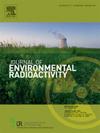90Sr and 137Cs distribution in Chornobyl forests: 30 years after the nuclear accident
IF 1.9
3区 环境科学与生态学
Q3 ENVIRONMENTAL SCIENCES
引用次数: 0
Abstract
The primary aim of this study was to quantify patterns in the distribution of 90Sr and 137Cs activity in pine (Pinus sylvestris L.: 18 sites) and birch (Betula pendula Roth.: 2 sites) forests within the Chornobyl exclusion zone, 30 years after the Chornobyl nuclear power plant (NPP) accident (1986). To achieve this, radionuclide activity concentrations were measured in the mineral and organic soil horizons, the green forest floor (grasses, mosses, and lichens), and trunk wood in forest plots dominated by either pine or birch trees.Our results showed that the geometric mean of the 90Sr aggregated transfer factors from mineral soil to the trunk wood of pine trees (Tag) for Scots pines was 24 x 10−3 m2 kg−1, which is an order of magnitude higher than the IAEA Handbook (2010)reference value (1.7 x 10−3 m2 kg−1), which were based on studies conducted after the Kyshtym accident (Ural region, Russia) and in the first years following the Chornobyl accident (Ukraine and Belarus). The observations suggest that the above-ground biomass (soil organic layers, green forest floor, and trees) may contribute more to the 90Sr inventory than the mineral soil at the stand level. In contrast, the 137Cs Tag values for pine and birch stands were consistent with those reported in the literature (ranging from 0.1 to 10 and 0.5-1.1 x 10−3 m2 kg−1, respectively). Both results align with the known bioavailability of radionuclides from previous studies: low for 137Cs, leading to limited soil depth migration (less than 30 cm in the mineral horizon), and higher for 90Sr, resulting in greater soil migration (up to 1 m in the mineral horizon). This study highlighted significant correlations between the radionuclides' activity concentrations in the litter layers and their content in the trunk wood of pine trees.
90Sr和137Cs在切尔诺贝利森林中的分布:核事故后30年。
本研究的主要目的是量化松树(Pinus sylvestris L.: 18)和桦树(Betula pendula Roth) 90Sr和137Cs活性的分布规律。(2个地点)切尔诺贝利禁区内的森林,切尔诺贝利核电站(NPP)事故(1986)30年后。为此,测量了矿物和有机土壤层、绿色森林地面(草、苔藓和地衣)以及以松树或桦树为主的森林地块的树干木材中的放射性核素活性浓度。我们的研究结果表明,苏格兰松从矿物土壤到松树树干木材的90Sr聚集转移因子(Tag)的几何平均值为24 x 10-3 m2 kg-1,比国际原子能机构手册(2010)参考值(1.7 x 10-3 m2 kg-1)高出一个数量级,该参考值是基于在Kyshtym事故后(俄罗斯乌拉尔地区)和切尔诺贝利事故后第一年(乌克兰和白俄罗斯)进行的研究。结果表明,地上生物量(土壤有机层、绿色森林地面层和树木)对90Sr储量的贡献可能大于林分水平的矿质土壤。相比之下,松林和桦林的137Cs Tag值与文献报道一致(分别为0.1 ~ 10和0.5 ~ 1.1 x 10-3 m2 kg-1)。这两个结果都与先前研究中已知的放射性核素生物利用度一致:137Cs低,导致有限的土壤深度迁移(在矿物层中小于30厘米),90Sr高,导致更大的土壤迁移(在矿物层中高达1米)。本研究强调了凋落物层放射性核素活性浓度与松树树干中放射性核素含量之间的显著相关性。
本文章由计算机程序翻译,如有差异,请以英文原文为准。
求助全文
约1分钟内获得全文
求助全文
来源期刊

Journal of environmental radioactivity
环境科学-环境科学
CiteScore
4.70
自引率
13.00%
发文量
209
审稿时长
73 days
期刊介绍:
The Journal of Environmental Radioactivity provides a coherent international forum for publication of original research or review papers on any aspect of the occurrence of radioactivity in natural systems.
Relevant subject areas range from applications of environmental radionuclides as mechanistic or timescale tracers of natural processes to assessments of the radioecological or radiological effects of ambient radioactivity. Papers deal with naturally occurring nuclides or with those created and released by man through nuclear weapons manufacture and testing, energy production, fuel-cycle technology, etc. Reports on radioactivity in the oceans, sediments, rivers, lakes, groundwaters, soils, atmosphere and all divisions of the biosphere are welcomed, but these should not simply be of a monitoring nature unless the data are particularly innovative.
 求助内容:
求助内容: 应助结果提醒方式:
应助结果提醒方式:


